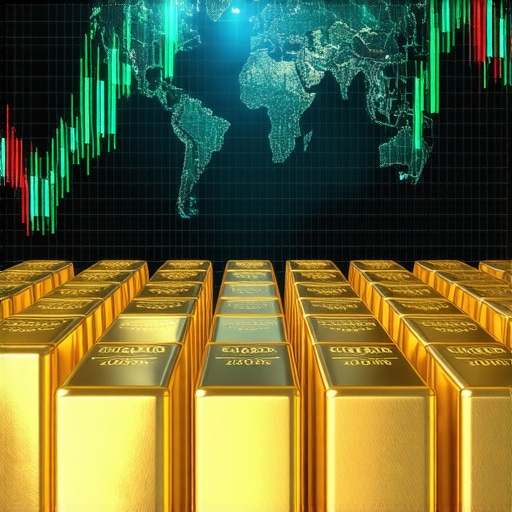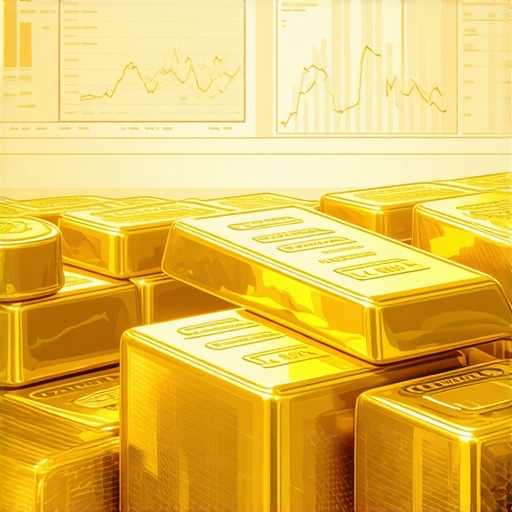Introduction to Gold Price Volatility
The price of gold is known for its fluctuations, influenced by a myriad of factors that can change rapidly. As we approach 2025, understanding the price volatility of gold becomes crucial for both seasoned investors and newcomers alike. This precious metal has long been a safe haven during economic uncertainty, but what does the future hold? In this article, we will explore the dynamics of gold pricing and offer insights into navigating its volatility.
Factors Influencing Gold Prices
Several key factors contribute to the fluctuations in gold prices. One of the primary influences is global economic conditions, including inflation rates, currency strength, and geopolitical tensions. For instance, when inflation rises, many investors flock to gold as a hedge against currency devaluation, driving prices higher. Conversely, a strong U.S. dollar can make gold more expensive for foreign investors, potentially leading to a decrease in demand.
Another significant factor is central bank policies. Central banks around the world hold vast reserves of gold, and their buying or selling activities can significantly impact market prices. For example, if a central bank decides to increase its gold reserves, it typically signals confidence in gold as a long-term investment, which can drive prices up. Conversely, selling off gold reserves may lead to a decline in prices as supply increases.
Investor sentiment also plays a critical role in determining gold prices. Trends in gold price forecasts often reflect the collective outlook of market participants. If investors perceive economic conditions as unstable, they may rush to invest in gold, causing prices to soar. Conversely, if the market feels secure, gold prices may drop as demand wanes.
Strategies for Navigating Gold Price Volatility
To successfully navigate the unpredictable nature of gold pricing, investors should consider several strategies. First, diversifying investments by incorporating a mix of gold ETFs and physical gold can help mitigate risks associated with price fluctuations. This approach allows investors to benefit from both the liquidity of ETFs and the tangible value of physical gold.
Another essential strategy is to stay informed about market trends and predictions. Understanding the factors that drive gold prices can empower investors to make informed decisions. Regularly reviewing expert analyses and market reports can provide valuable insights into potential price movements.
Additionally, implementing a long-term investment perspective can help weather the storms of volatility. Rather than attempting to time the market, a focus on gold as a long-term asset can yield substantial returns over time, especially as global economic uncertainties continue to unfold.
In summary, while the price volatility of gold presents challenges, it also offers opportunities for strategic investors. By understanding the underlying factors that influence gold prices and employing effective strategies, individuals can position themselves for success in the ever-changing landscape of gold investment as we approach 2025.
Understanding Gold Market Dynamics
The gold market operates on a complex interplay of various economic indicators and investor sentiments. In 2025, this complexity is expected to intensify, prompting investors to deepen their understanding of gold price trends and market dynamics. Investors should focus on key aspects such as supply and demand fundamentals, which play a pivotal role in shaping gold prices. Understanding how gold fits into a diversified investment portfolio can provide insights into its expected performance amidst market fluctuations.
Supply and Demand Dynamics in Gold Pricing
Gold prices are largely influenced by the balance of supply and demand. An increase in gold demand, whether from retail investors seeking safe-haven assets or from central banks accumulating reserves, can significantly drive up prices. Conversely, a surplus in supply, such as increased mining output, may lead to price declines. Investors should keep an eye on supply and demand trends to better anticipate potential shifts in the market.
Impact of Geopolitical Events on Gold Prices
Geopolitical events are another critical factor affecting gold prices. Tensions around the globe often lead to increased investor interest in gold as a safe-haven asset. In 2025, potential conflicts or economic sanctions may prompt a surge in gold buying, affecting its price volatility. Monitoring central bank purchasing behaviors can provide valuable insights into how geopolitical tensions may influence demand and, consequently, prices.
Long-Term Gold Investment Strategies
For savvy investors, adopting long-term strategies can be a key to successfully navigating gold price volatility. One effective approach is to regularly rebalance investment portfolios, ensuring that gold maintains an appropriate proportion in relation to other assets. This strategy helps mitigate risks associated with sudden price changes. Furthermore, investors should consider physical gold investments, which often serve as a hedge against inflation and currency fluctuations.
Diversifying with Gold ETFs
In addition to physical gold, diversifying with gold ETFs can provide liquidity and flexibility to investors. These exchange-traded funds track the price of gold and allow investors to gain exposure without needing to store physical bullion. As the market evolves, understanding how to diversify with gold ETFs can enhance risk management and investment efficiency.
Monitoring Expert Predictions
Staying informed about expert predictions and analyses is essential for navigating the complexities of gold pricing. Regularly reviewing gold price forecasts can help investors anticipate market movements and adjust their strategies accordingly. As 2025 unfolds, the insights provided by seasoned analysts can be invaluable in formulating informed investment decisions.
Conclusion: Preparing for the Future of Gold Investments
As we move deeper into 2025, the landscape of gold investment continues to evolve. Adopting a proactive approach to understanding market dynamics and implementing effective investment strategies can better equip investors to face the challenges posed by price volatility. Engaging with the latest trends and expert insights will be crucial in positioning oneself for success in this ever-changing market, highlighting the importance of continuous learning and adaptation in the gold investment arena.
Understanding the Role of Inflation in Gold Price Dynamics
Inflation is a significant factor affecting gold prices, particularly as we approach 2025. When inflation rises, the purchasing power of currency declines, prompting investors to seek protection through gold investments. As a result, the demand for gold often increases, which can lead to higher prices. Investors should keep a close eye on inflation indicators and economic reports to gauge how these factors might impact gold prices in the coming year.
Analyzing Economic Indicators That Influence Gold Prices
Several economic indicators play a crucial role in determining gold prices. These include interest rates, GDP growth, and employment data. For example, lower interest rates tend to decrease the opportunity cost of holding gold, making it a more attractive asset. Conversely, strong economic growth may lead to higher interest rates, which can put downward pressure on gold prices. Understanding these economic indicators can help investors anticipate market changes and adjust their strategies accordingly.
Global Supply Chain Dynamics and Their Effects on Gold Pricing
The global supply chain significantly impacts gold pricing, especially as we see fluctuations in mining output and production costs. A decrease in gold mining output due to geopolitical tensions or environmental regulations can lead to supply shortages, driving prices higher. Conversely, an increase in production could result in lower prices. Investors should monitor supply chain trends to better understand how they affect gold market dynamics.
The Importance of Central Bank Policies in Gold Investment
Central banks are among the largest holders of gold, and their policies can significantly impact market prices. For instance, if central banks increase their gold reserves, it often signals confidence in gold as a stable investment, prompting other investors to follow suit. Additionally, central banks may adjust their gold buying strategies based on economic forecasts, which can influence overall demand. Keeping track of central bank activities can provide valuable insights for investors looking to navigate the market effectively.
Investor Sentiment: A Driving Force Behind Gold Prices
Investor sentiment is a critical aspect of gold price dynamics. In times of uncertainty, such as during economic downturns or geopolitical conflicts, investors typically flock to gold as a safe haven. This increased demand can result in price surges, making it essential for investors to gauge market sentiment. Staying informed about market news and expert analyses can help investors understand shifts in sentiment that could impact their gold investment strategies.
Utilizing Technology to Monitor Gold Price Movements
In the digital age, technology plays a pivotal role in tracking gold prices and market trends. Numerous apps and platforms provide real-time data on gold prices, allowing investors to make informed decisions quickly. Utilizing these tools can enhance an investor’s ability to respond promptly to market fluctuations, ensuring they can capitalize on opportunities as they arise. Furthermore, understanding how to interpret price fluctuations can help investors better navigate the complexities of the gold market.
Understanding Gold Investment Risks
Investing in gold presents a unique set of risks that every potential investor should understand. While gold is often viewed as a safe haven during economic downturns, its price can still experience significant fluctuations. Factors such as market speculation and unexpected economic indicators can lead to rapid price changes. This makes it essential for investors to stay informed and develop a robust risk management strategy. For instance, adopting top investment strategies can help investors mitigate the effects of these risks.
Market Timing: The Art of Investing in Gold
Another critical aspect of gold investment is the concept of market timing. Knowing the right time to buy or sell can significantly affect returns. Investors should pay attention to seasonal trends and historical price data to identify potential entry and exit points. For example, gold prices may rise during times of economic uncertainty or geopolitical tensions. Understanding these trends can be instrumental in making informed decisions, as outlined in our guide on gold price forecasts.
Utilizing Technical Analysis for Gold Trading
Technical analysis is a valuable tool for investors looking to navigate gold price volatility. By analyzing past price movements and trading volumes, investors can identify patterns that may indicate future price behavior. This analytical approach can provide insights into potential price corrections or bullish trends, enabling investors to make timely decisions. For those interested in learning more about these techniques, our post on gold trading techniques is an excellent resource.
Environmental and Regulatory Factors Affecting Gold Prices
As we approach 2025, environmental and regulatory factors are becoming increasingly relevant in gold mining and production. Stricter regulations aimed at reducing environmental impact can lead to higher operational costs for mining companies. Consequently, these costs may be passed on to consumers, driving up gold prices. Investors should monitor regulatory developments and their potential implications on gold demand trends to stay ahead in the market.
Gold as a Hedge Against Currency Weakness
Gold has long been considered a hedge against currency weakness and inflation. As currencies fluctuate, many investors turn to gold to preserve their purchasing power. This asset’s value often increases when confidence in fiat currencies declines. Understanding the relationship between currency movements and gold prices can provide investors with a strategic advantage. For further insights, visit our guide on gold as a hedge.
Conclusion: Preparing for a Dynamic Gold Market
As we look forward to 2025, the gold market is poised for dynamic changes influenced by various economic, political, and environmental factors. By understanding the complexities of gold pricing and employing effective investment strategies, investors can better navigate this volatile landscape. Continuous learning and adaptation will be essential for achieving success in gold investment. For those ready to explore more strategies, check out our comprehensive resources on gold investment strategies.
Frequently Asked Questions About Gold Price Volatility
What causes gold price fluctuations?
The price of gold fluctuates due to various factors, including global economic conditions, inflation rates, interest rates, and geopolitical tensions. These elements can affect investor sentiment and demand for gold, leading to price changes.
How can I protect my investments from gold price volatility?
To protect your investments from gold price volatility, consider diversifying your portfolio with a mix of gold ETFs and physical gold. Additionally, staying informed about market trends and employing a long-term investment strategy can help mitigate risks.
Is investing in gold a safe option during economic downturns?
Gold is often considered a safe-haven asset during economic downturns. Investors typically turn to gold as a hedge against currency devaluation and inflation, which can stabilize its value compared to other assets.
What role do central banks play in gold pricing?
Central banks are significant players in the gold market, holding large reserves. Their buying and selling actions can impact gold prices significantly. For example, increased purchases by a central bank can signal confidence in gold, driving prices higher.
How does inflation affect gold prices?
Inflation tends to drive gold prices up as the purchasing power of currency declines. Investors seek gold to preserve their wealth, leading to increased demand and consequently higher prices.
What are the risks associated with investing in gold?
Investing in gold carries risks such as market speculation, price volatility, and changes in economic indicators like interest rates. It’s essential for investors to stay informed and develop a risk management strategy to navigate these risks effectively.
What are the advantages of gold ETFs compared to physical gold?
Gold ETFs offer liquidity, ease of trading, and no need for physical storage, making them an attractive option for many investors. They track the price of gold and provide exposure without the hassles of owning physical bullion.
How can technology assist in tracking gold prices?
Technology plays a crucial role in tracking gold prices through various apps and online platforms that provide real-time data. Investors can use these tools to monitor price movements and make informed decisions based on current market conditions.
What should I consider before investing in gold?
Before investing in gold, consider factors such as your investment goals, risk tolerance, market trends, and the overall economic environment. Understanding these aspects can help you make informed decisions about your gold investments.
Authority Resources for Gold Investment Insights
To further enhance your understanding of the price volatility of gold and investment strategies, consider these trusted resources:
- World Gold Council – Provides insights on gold’s role in investment portfolios and current market trends.
- Kitco News – Offers real-time gold prices, news, and expert analyses.
- Investopedia – A comprehensive resource for financial education, including articles on gold investment strategies and market analysis.
- Bloomberg Commodities – Features market news, prices, and expert commentary on gold and other commodities.
- Reuters – Provides breaking news and detailed insights into global market trends affecting gold prices.
Conclusion: Embracing Gold Investment Opportunities
As we head into 2025, understanding the price volatility of gold is essential for investors seeking to capitalize on opportunities in this dynamic market. By staying informed about global economic conditions, central bank policies, and investor sentiment, individuals can better navigate the complexities of gold investment. The strategies discussed, from diversifying with gold ETFs to monitoring expert predictions, serve as a foundation for successful investing. Continuous learning and adaptation will empower investors to thrive despite the challenges posed by price fluctuations, ultimately leading to informed and strategic decisions in the gold market.










Gold has always intrigued me, especially considering its role as a safe haven during tumultuous economic times. With rising inflation and geopolitical tensions, as discussed in the article, it’s fascinating to see how these factors intertwine with the pricing of gold. I find it particularly interesting how central bank activities, as well as investor sentiment, can dramatically sway prices. During uncertain times, like we’re experiencing now, I’ve noticed a significant increase in interest from both seasoned investors and newcomers alike who are looking to gold as a hedge against potential currency weakness.
The strategies you mentioned for navigating price volatility, such as diversifying with gold ETFs and physical gold, have been beneficial for investors looking to balance their portfolios. I’ve been utilizing a mix of both and have found that it provides a good safety net amid market fluctuations. Moreover, staying updated on expert analyses has become essential for me, as it helps in anticipating market movements. As we approach 2025, I believe a long-term perspective will be pivotal for gold investors to ride out any volatility.
Alexander, I appreciate your insights on the interplay between central bank policies and investor sentiment influencing gold prices. Building on that, I’ve found that the unpredictable nature of geopolitical tensions adds another layer of complexity that can lead to sudden price surges or dips, which aren’t always anticipated in standard forecasts. In my experience, this makes the strategy of blending physical gold holdings with gold ETFs even more valuable, as it provides flexibility and a buffer against abrupt market shifts. Moreover, keeping an eye on inflation trends is equally critical since rising inflation often drives a rapid increase in demand for gold as a hedge, but the timing can be tricky to predict. I’m curious—how do you balance staying informed about these multiple influencing factors without getting overwhelmed, especially with the volume of expert analyses and forecasts available? Have you found any particular tools or sources that help streamline this information for practical decision-making? Sharing experiences like this could really help others who want to navigate the volatility effectively as 2025 approaches.